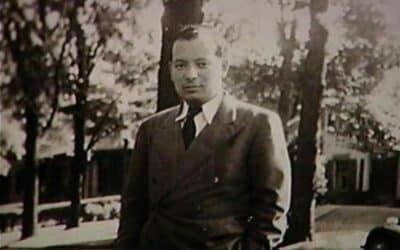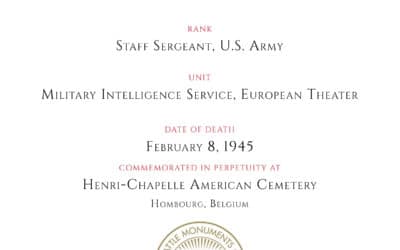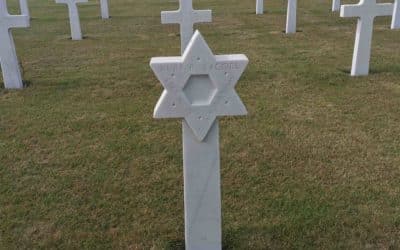People A-Z / Kurt R. Jacobs
Soldier, Military Intelligence Service, WWII, “Ritchie Boy”.
Overview
Kurt Jacobs was born Kurt Jacobsohn in Berlin, Germany in November 1909 and studied law, but eventually made a career in clothing and manufacturing. In 1936, at the age of 26, in order to escape increasing state sponsored antisemitism in Germany, he emigrated to Buffalo through the aid of an aunt: Cecilia Boasberg. With knowledge of English, he worked at Barmon Brothers, a women’s clothing outfitter, and was able to bring his mother, Bertha Jacobsohn, to Buffalo in August 1939, just before the outbreak of WWII in Europe in September 1939. His father Jakob Jacobsohn was unable to leave in time and died on September 15, 1942 in Terezín (Theresienstadt) then within German occupied Czechoslovakia.
A few months later, on November 13, 1942, Kurt volunteered for military service in the US Army, identity number 12207399. He was inducted into the US Army Signal Corps, and as a native German speaker was selected for training in military intelligence at Camp Ritchie, Maryland. At the training camp he, and other native German speakers, were trained in interrogation techniques and intelligence collecting for service in the European Theater of Operations (ETOUSA). Nearly 2,000 German-born Jews were trained at Camp Ritchie and assembled into Interrogation of Prisoner of War (IPW) teams, that were attached to frontline units. Kurt Jacobs was assigned to the 106th Infantry Division, IPW Team #154.
On December 20, 1944 at Bleialf in Germany, during the Battle of the Bulge (December 1944 and January 1945), several hundred soldiers of the 106th Infantry Division were captured by the 2nd Battalion, 293rd Volks Grenadier Regiment, and the 18th Volks Grenadier Division commanded by Curt Bruns. Some of the German Prisoners of War informed Bruns that two of the American soldiers were German speaking and formerly “Jews from Berlin.” Bruns ordered the execution of Staff Sergeant Kurt R. Jacobs and Technician Murray Zappler. Their bodies were recovered by American forces on 13 February 1945 and they were buried in Foy, at an American Temporary Cemetery. This cemetery was a resting place from 1945 to 1948 for the more than 2000 Americans killed in action in the Battle of the Bulge. In April 1945, Curt Bruns was tried for War Crimes, found guilty, and executed for the murder of the two Jewish soldiers.
Rosalind Pohl Jacobs, wife of Kurt Jacobs was initially told that her husband was missing in action on December 16, 1944, and then Killed in Action in February 1945. On March 14th, 1945, she was notified that her husband had been awarded the Purple Heart posthumously. Kurt Jacobs was reinterred at the Henri-Chapelle American Cemetery and Memorial, Arrondissement de Verviers, Liège, Belgium, in Plot G, Row 4, Grave 36. His grave marker is maintained by cemetery sentinels, Robby Meers, and Franky Meers. A permanent yahrzeit is maintained for Kurt at Temple Beth Zion.
Websites
Listing of Kurt R. Jacobs.
New York State Military Museum and Veterans Research Center
US Soldiers Buried Overseas
Aimee Gagnon Fogg has researched many of those killed during the war and buried at Henri-Chapelle American Cemetery. She has published her research in longer format within several books and a website.
Video
CBS, “The Ritchie Boys,” 60 Minutes, May 9, 2021
Special segment on the Jews who escaped the Nazis and returned with the U.S. Army to fight Hitler during WWII. (Subscription may be required)
Stephan H. Lewy, Holocaust Resource Center of Buffalo.
“Ritchie Boys” used their language skills to win American battlefield victories by gaining critical tactical information from German POWs. Another Ritchie Boy and former child refugee, who eventually settled in Buffalo, NY, Stephan Lewy, obtained tactical information from German POW’s that enabled American Forces to destroy a German infantry division. He was also part of a contingent of troops who opened Buchenwald concentration camp, learning first-hand the horrors of antisemitic Nazi policies towards Jews.
Well in his 90s, Stephan Lewy made his testimony available through the Holocaust Resource Center of Buffalo and through interviews in many outlets including the Buffalo News. He spoke about his life as a child refugee, Kristallnacht, his training at Camp Ritchie and his work during the war as a part of US military forces, among many other experiences. His archives are available online in part through the Holocaust Resource Center and more extensively through the United States Holocaust Memorial Museum.
Oral history interview with Stephan Lewy
United States Holocaust Memorial Museum
Holocaust survivor recalls atrocities by Nazis
Gene Warner, “Holocaust survivor recalls atrocities by Nazis,” Buffalo News, September 27, 2016,
Gallery
Kurt R. Jacobs, Soldier, Ritchie Boy, WWII. Image from the interviews of Ernest Sternglass, 1997, USC Shoah Foundation with the aid of Aimee G. Fogg
Kurt R. Jacobs, Soldier, Killed in Action, WWII
Staff Sergeant Kurt R. Jacobs Killed in Action, Buffalo Jewish Review, March 30, 1945, p.3. Courtesy of the University Archives, University at Buffalo, NY.
Kurt R. Jacobs, Buffalo Jewish Review, 1945
American Battle Monuments Commission, Kurt R. Jacobs, Certificate
American Battle Monuments Commission, Kurt R. Jacobs, Certificate
Kurt Jacobs Grave Marker, Henri-Chapelle American Cemetery and Memorial, Belgium, Photograph courtesy of Franky and Robbe Meers. Used with Permission.
Kurt Jacobs Grave Marker
Jewish War Veterans, Buffalo Frontier Post no. 25, Memorial Plaque, photograph created by Izon Productions-Don Dannecker, 2015. Courtesy of the Foundation for Jewish Philanthropies.
Jewish War Veterans, Buffalo Frontier Post no. 25, Memorial Plaque
Discover More
Books and Articles
- Selig Adler and Thomas F. Connelly. From Ararat to Suburbia: The History of the Jewish Community of Buffalo. Philadelphia: Jewish Publication Society, 1960, p. 404.
- Christian Bauer and Rebekka Gopfert, Die Ritchie Boys. Deutsche Emigranten beim US-Geheimdienst. Hoffmann und Campe, 2005.
- Steve Blizard and Kathy Fotheringham, Fort Ritchie 1926-1998. Herff Jones Yearbooks, 1998.
- Beverley Driver Eddy, Ritchie Boy Secrets : How a Force of Immigrants and Refugees Helped Win World War II. Stackpole Books, 2021.
- Bruce Henderson, Sons and Soldiers: The Untold Story of the Jews Who Escaped the Nazis and Returned with the U.S. Army to Fight Hitler. William Morrow, 2017.
- David Vergun, “Ritchie Boys’ Aided Army’s Efforts to Defeat Germany During WWII,” Department of Defense News, January 27, 2020.
- Nick Poppy, “How German-born ‘Ritchie Boys’ helped America defeat Hitler,” New York Post, July 25, 2017
Primary Sources
- Report about the murder of Kurt Jacobs and Murray Zappler, and the trial of Curt Bruns for war crimes.
- Forest Lawn Cemetery Database
- National Archives and Records Administration. World War II and Korean Conflict Veterans Interred Overseas. Provo, UT, USA.
- Individual Deceased Personnel File
An Individual Deceased Personnel File or IDPF is a personnel file created by the military services to document the death of a military service member and information about the disposition of the remains (and therefore also known as “Mortuary File” or “Casualty File”). The IDPF can be used as a tool for reconstructing the service history of veterans who were killed in action or died during the service. The IDPF file of Kurt Jacobs includes correspondence between Rosalind Jacobs and various USA military branches as well as other information relating to Kurt Jacobs burial first at Foy, and then at the Henri-Chapelle American Cemetery.
Thank You
The JBHC would like to thank the following individuals from the US and Belgium for their help in researching this biography: Beverley Driver Eddy, John Edens, Aimee Gagnon Fogg, Bernie Lubran, Franky Meers, Robbe Meers, Dan Gross and Al Gross.
Contribute to this page
If you have any other information concerning Kurt Richard Jacobs please contact us.










